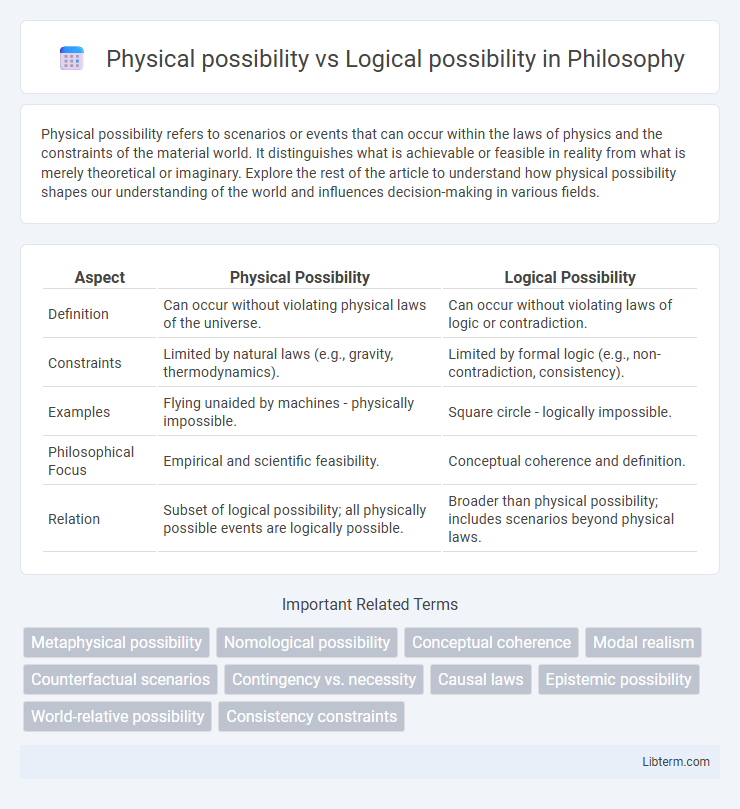Physical possibility refers to scenarios or events that can occur within the laws of physics and the constraints of the material world. It distinguishes what is achievable or feasible in reality from what is merely theoretical or imaginary. Explore the rest of the article to understand how physical possibility shapes our understanding of the world and influences decision-making in various fields.
Table of Comparison
| Aspect | Physical Possibility | Logical Possibility |
|---|---|---|
| Definition | Can occur without violating physical laws of the universe. | Can occur without violating laws of logic or contradiction. |
| Constraints | Limited by natural laws (e.g., gravity, thermodynamics). | Limited by formal logic (e.g., non-contradiction, consistency). |
| Examples | Flying unaided by machines - physically impossible. | Square circle - logically impossible. |
| Philosophical Focus | Empirical and scientific feasibility. | Conceptual coherence and definition. |
| Relation | Subset of logical possibility; all physically possible events are logically possible. | Broader than physical possibility; includes scenarios beyond physical laws. |
Defining Physical Possibility
Physical possibility refers to scenarios that can occur within the laws of the natural world and the constraints of physical reality, such as biochemistry or the speed of light. It emphasizes what actions or events can actually happen given current scientific understanding and physical limitations. Unlike logical possibility, which concerns coherence and consistency in ideas or propositions regardless of real-world feasibility, physical possibility is grounded in empirical and measurable phenomena.
Understanding Logical Possibility
Logical possibility refers to scenarios that do not entail contradictions within a defined set of rules or principles, emphasizing coherence over empirical constraints. Unlike physical possibility, which is limited by natural laws and observable phenomena, logical possibility allows for the conception of events or entities that can be consistently imagined or described without violating logical consistency. Understanding logical possibility involves recognizing the distinction between what can be conceived without contradiction and what can occur in the actual world governed by physical laws.
Key Differences between Physical and Logical Possibility
Physical possibility refers to conditions that can exist within the laws of physics and nature, emphasizing real-world feasibility. Logical possibility concerns scenarios that do not contain contradictions within formal logic, regardless of physical laws. Key differences include that physical possibility depends on empirical constraints, while logical possibility is bound only by consistency in reasoning and conceptual coherence.
Examples of Physically Possible but Logically Impossible Scenarios
A classic example of a physically possible but logically impossible scenario is a time machine that travels to the past and simultaneously causes its own creation, illustrating a causal loop without a clear origin. Another example involves quantum superposition states where particles exist in multiple locations physically, yet logically, an object occupying contradictory states at once defies classical reasoning. These scenarios highlight distinctions where physical laws permit phenomena that challenge traditional logical consistency or entail paradoxes.
Examples of Logically Possible but Physically Impossible Scenarios
A spaceship traveling faster than the speed of light is logically possible within the realm of theoretical physics but violates physical laws such as Einstein's theory of relativity, making it physically impossible. Another example is a perfectly spherical object existing in a universe where quantum fluctuations prevent absolute smoothness, so its logical definition holds but physical realization is constrained. Similarly, time travel to the past conflicts with causality principles and currently lacks a physical mechanism, though it remains logically coherent as a concept in theoretical models.
Role in Philosophy of Science
Physical possibility concerns what can occur within the laws of nature and empirical constraints, playing a crucial role in scientific theorizing and experimentation by defining feasible scenarios. Logical possibility involves consistency within a system of propositions or concepts, serving as the basis for conceptual analysis and hypothesis formation in the philosophy of science. Distinguishing between these possibilities helps scientists and philosophers evaluate the validity of models and the likelihood of phenomena in both empirical and conceptual domains.
Implications for Scientific Theories
Physical possibility limits outcomes based on natural laws and empirical constraints, directly shaping the formulation and testing of scientific theories. Logical possibility allows for conceptual scenarios regardless of physical laws, providing a framework for theoretical models and hypotheses that challenge current understanding. Distinguishing between these possibilities helps scientists identify which theories are empirically viable and which remain speculative or purely conceptual.
Impact on Thought Experiments
Physical possibility restricts scenarios based on natural laws and empirical constraints, shaping thought experiments to remain feasible within our universe's parameters. Logical possibility allows for the exploration of scenarios that defy physical laws but maintain internal consistency, expanding the conceptual boundaries and testing philosophical principles. The interplay between these possibilities impacts the scope and relevance of thought experiments in fields such as metaphysics, epistemology, and philosophy of mind.
Addressing Common Misconceptions
Physical possibility refers to scenarios consistent with the laws of nature, whereas logical possibility involves scenarios free from contradictions within a system of logic. A common misconception is that if something is logically possible, it must also be physically possible, which overlooks natural limitations imposed by physics. Recognizing this distinction prevents conflating conceptual coherence with empirical feasibility in philosophical and scientific discussions.
Conclusion: The Importance of Distinguishing Possibilities
Distinguishing physical possibility from logical possibility is crucial for understanding the limits of reality and conceptual coherence. Physical possibility depends on the laws of nature and empirical evidence, while logical possibility relies on consistency within formal systems and absence of contradictions. Recognizing this distinction prevents conflating what can occur in the actual world with what can be conceived, guiding accurate reasoning in philosophy, science, and artificial intelligence.
Physical possibility Infographic

 libterm.com
libterm.com